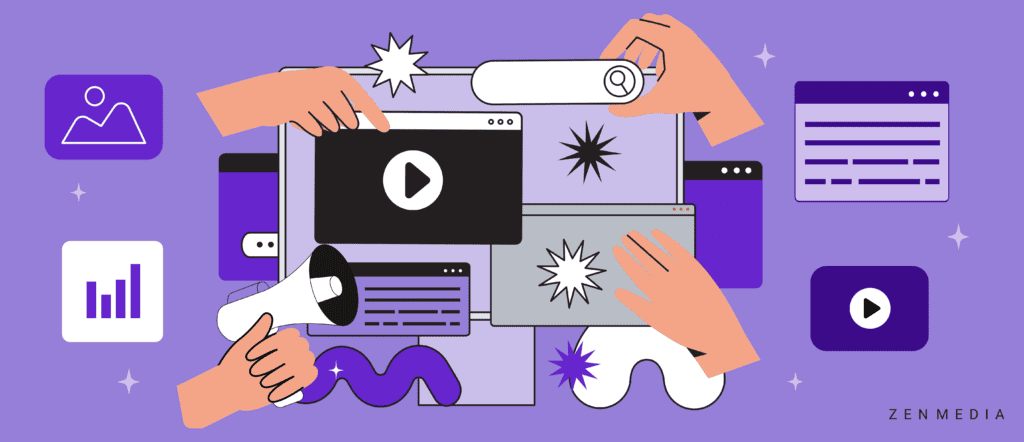When we develop our outreach strategy for a client, we include plans for each of the four different types of media:
Rented Media: Platforms or channels where you share space with others but do not own or control.
Owned Media: Channels that are company-specific and where you control the content and platform.
Paid Media: Advertising you pay for to promote content through various channels.
Earned Media: Publicity gained through promotional efforts other than advertising.
Let’s dive deeper into each of these different types, so you can see how they work together and what they can each do for your brand.
What is rented media?
Social media, baby! Rented media has become a huge component of digital marketing and PR strategies because the majority of consumers use social media. This includes branded B2B content, original content posted on brand platforms, as well as the content that brands share from other outlets.
Rented media has two components, though. It’s about putting content out there, but it’s also about the exchange you have with your audience. Interacting with audiences through rented media, or social media, can boost a brand’s trustworthiness. This could be through Instagram or Facebook Live sessions, through discussions in the comments on LinkedIn, and so on.
What is owned media?
Owned media is everything that the company or brand has full control over. Think of a website, a blog, original content, videos, streaming sessions, infographics, and white papers. These are the assets that fuel the other three types of media, and they’re equally as important in building a successful B2B marketing strategy.
Owned media is essential because it is the most direct way that potential customers come in contact with your brand.
Specialist ID’s blog is a great example of owned media. The content created on their blog is something they have total control over, and it’s something they can share on their other owned, as well as rented, platforms.
What is paid media?
Paid media includes everything from PPC (pay-per-click) ads to B2B influencer marketing, social media ads, and sponsored content (like advertorials or guest columns that you pay for in exchange for exposure).
While it’s nice to think that if you create great content, it will work on its own to get eyes on your brand, you simply can’t rely on organic reach alone. With the sheer volume of content online, the competition is too great to guarantee your audience’s attention.
Plus, a paid media strategy is important for your digital marketing because it can extend your brand’s reach to audiences that would not have been able to find you organically. Paid media helps brands target the right people at the right times, so they can cut through the noise online and increase brand awareness.
Here at Zen Media, we use paid ads on social media, PPC, and email marketing to extend our reach (read: we practice what we preach).
What is earned media?
When you think of traditional public relations, you’re probably thinking along the lines of earned media. Within the scope of earned media, you’ll find mentions in newspapers, trade publications, magazines, podcasts, radio, TV, and so on. “Media hits” are earned media, anything that draws the attention of the press so that your brand visibility is increased.
Earned media might seem like a very traditional or typical strategy, but it’s certainly not outdated. A comprehensive PR and marketing strategy relies on elements of earned media because outlets — like newspapers, trade publications, magazines, podcasts, radio, TV, and more — have credibility and reach that most companies don’t. A feature in an earned media outlet augments both your brand’s reputation and trustworthiness, while also extending the reach of your brand.
Anyone can (and should!) buy an ad, but when you earn the right to be featured in an article you’re elevated to an entirely new level of credibility and recognition.
Continue reading: Actionable strategies to make the most of B2B sales and marketing in 2024
How Dark Social Plays Into ROPE
While we just outlined the visible, or public, forms of media and advertising, there’s another form of media that cannot go unmentioned: Dark social.
Dark social is when media is sent and received privately. This includes WhatsApp, Facebook Messenger, and other private forms of one-to-one or small group chat communication. An estimate shows that 12.1% of mobile users in the U.S. use WhatsApp, and 56.8% use Facebook Messenger.
The number of shares that happen via this method is massive—according to data from RhythmOne, 84% of shares happen via dark social. This presents an obvious problem: how do you track dark social shares? To some degree, you can’t—at least not for rented or earned media. With the right software, however, you can track the reach of your owned media, even on dark social.
Since so much share traffic happens on dark social, you will need to trust that the combination of media channels assures that your brand is being seen (and shared!). It’s up to your marketing team to ensure that the components of ROPE are playing well together to keep people’s eyes on your brand and grow audiences in different spaces, whether you can track them or not.
Our founder, Shama Hyder, first mentioned the links between ROPE and dark social on the Marketing Leadership Podcast: Strategies from Wise D2C & B2B Marketers. In the episode, Shama emphasizes the problems brands might encounter when they isolate each component and try to serve an outdated top- or bottom-of-funnel marketing model.
Instead, brands can lean on ROPE and dark social to understand the “messy middle,” or the true representation of the modern buyer’s journey that sees consumers experiencing a constant state of research and exposure—both publicly and privately—before purchasing.
When brands implement a ROPE strategy that includes dark social, they increase their exposure and conversion rates as a result.
How do the separate pieces of the ROPE Marketing Model work together?
Each element of the ROPE Marketing Model relies on the others. For example, to create social posts that drive sales, brands need content to share online—what we would call owned media. To grow a following for this owned media, brands need earned media to direct potential buyers to the content. And to direct potential buyers to the content that companies and brands need to share their work online, you need rented and paid media.
Each element is connected.
How does the customer buying journey work with the ROPE Marketing Model?
As you can see in the illustration, the customer buying journey is not linear—it starts, continues, doubles back on itself, and interacts with each of the types of media at different times and in different ways.
This is why reaching your customers through multiple channels, multiple types of content, and at many different points throughout that journey is so important. That, in a nutshell, is what the ROPE Marketing Model does.
Building a successful digital PR and marketing strategy requires all of these facets because, when combined, they have a greater success rate for reaching the target audience.
Continue reading: Why Do You Need Digital Market Research?
Is the ROPE Marketing Model effective?
We wouldn’t use it if it wasn’t, *wink wink.* Curious about what this could look like for you? Send us a note — let’s talk it through.





